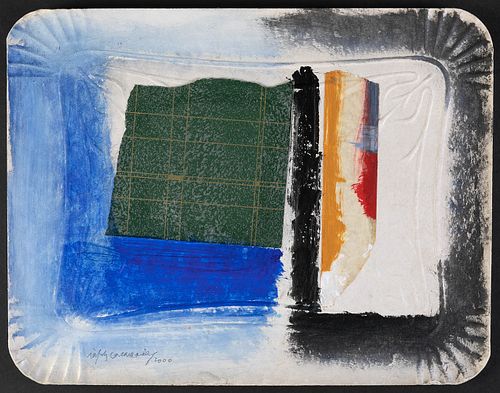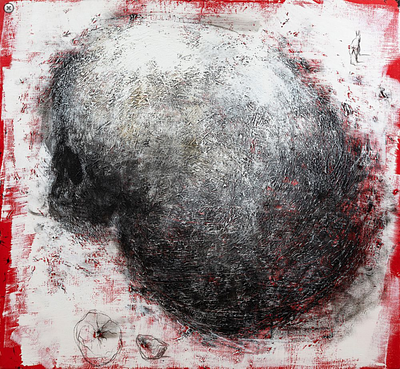ALBERT RÀFOLS CASAMADA (Barcelona, 1923 - 2009). "Safata", 2000. Painting and collage on cardboard tray.
Lot 35
About Seller
Setdart Auction House
Carrer Aragó 346
Barcelona
Spain
Setdart Subastas was born in 2004 and is currently the first online art auction in Spain with solidity, prestige and reliability guaranteed by our more than 60,000 users. Setdart has a young, dynamic and enterprising team ready to successfully manage the purchase and sale of art works through custom...Read more
Categories
Estimate:
EUR€1,800 - EUR€2,000
$1,914.89 - $2,127.66
Absentee vs Live bid
Two ways to bid:
- Leave a max absentee bid and the platform will bid on your behalf up to your maximum bid during the live auction.
- Bid live during the auction and your bids will be submitted real-time to the auctioneer.
Bid Increments
| Price | Bid Increment |
|---|---|
| EUR€0 | EUR€10 |
| EUR€200 | EUR€25 |
| EUR€500 | EUR€50 |
| EUR€1,000 | EUR€100 |
| EUR€3,000 | EUR€200 |
| EUR€5,000 | EUR€500 |
| EUR€10,000 | EUR€1,000 |
| EUR€20,000 | EUR€2,000 |
| EUR€50,000 | EUR€5,000 |
About Auction
By Setdart Auction House
Oct 19, 2021
Set Reminder
2021-10-19 08:00:00
2021-10-19 08:00:00
America/New_York
Bidsquare
Bidsquare : CONTEMPORARY ART
https://www.bidsquare.com/auctions/setdart-auction-house/contemporary-art-7701
Setdart Auction House sofia@setdart.com
Setdart Auction House sofia@setdart.com
- Lot Description
ALBERT RÀFOLS CASAMADA (Barcelona, 1923 - 2009). "Safata", 2000. Painting and collage on cardboard tray. Signed and dated in the lower left corner. Titled on the back. Provenance: Private collection. Measurements: 34 x 44 cm. From the year 63 Ráfols Casamada will incorporate to his art the collage technique, practicing it since then until the end of his career. As the artist himself stated, his interest in collage was awakened by two exhibitions of the German Kurt Schwitters and Joan Miró respectively, which he was able to visit in Paris. The newspaper clippings, bus tickets, or other banal objects with which he constructed his collages were for Ràfols "Small traces of life full of poetry". Painter, educator, writer and graphic artist, Ràfols Casamada enjoys great international prestige today. He began in the world of drawing and painting with his father, Albert Ràfols Cullerés. In 1942 he began studying architecture, although he soon abandoned it to devote himself to the plastic arts. The post-impressionist paternal influence and his particular cézannism mark the works presented in his first exhibition, held in 1946 at the Pictòria galleries in Barcelona, where he exhibited with the group Els Vuit. Subsequently, he will elaborate a poetic abstraction, amorphous in its configuration, free and intelligent, the result of a slow gestation and based on environments, themes, objects or graphics of everyday life. Ràfols Casamada works with these fragments of reality, of life, in a process of disfigurement, playing with the connotations, the plastic values and the visual richness of the possible different readings, in an attempt to fix the transience of reality. In 1950 he obtained a scholarship to travel to France, and settled in Paris until 1954. There he became acquainted with post-cubist figurative painting, as well as the work of Picasso, Matisse, Braque and Miró, among others. These influences were joined in his painting to that of American abstract expressionism, which was developing at the same time. When he finally returned to Barcelona, he embarked on his own artistic path, with a style characterized by compositional elegance, based on orthogonal structures combined with an emotive and luminous chromaticism. After showing an interesting relationship, in the sixties and seventies, with neo-dada and new realism, his work has focused on purely pictorial values: fields of color in expressive harmony on which gestural charcoal lines stand out. He has received many awards, such as the National Plastic Arts Award of the Ministry of Culture in 1980, the Creu de Sant Jordi in 1982 or the Arts Award of the CEOE in 1991. In 1985 he was named Knight of the Order of Arts and Letters of France, and is an honorary member of the Royal Academy of Fine Arts of San Fernando in Madrid. In 2003 the Generalitat awarded him the National Visual Arts Prize of Catalonia, and in 2009, just two months before his death, Grup 62 paid tribute to him at the National Art Museum of Catalonia. His work can be found in the most important museums around the world: the Reina Sofia in Madrid, the Guggenheim and MOMA in New York, the Museum of Modern Art in Los Angeles, the Picasso Museum in France, the Georges Pompidou in Paris and the British Museum and the Tate Gallery in London, among many others.
- Shipping Info
-
In-house shipping available. Please inquire at admin@setdart.com.
-
- Buyer's Premium



 EUR
EUR CAD
CAD AUD
AUD GBP
GBP MXN
MXN HKD
HKD CNY
CNY MYR
MYR SEK
SEK SGD
SGD CHF
CHF THB
THB
















